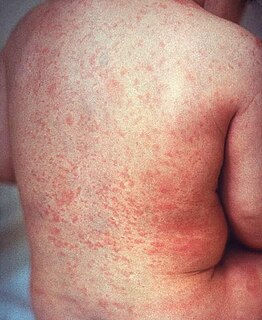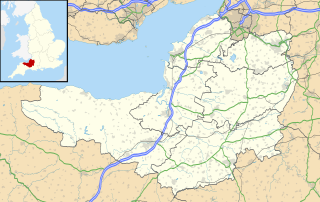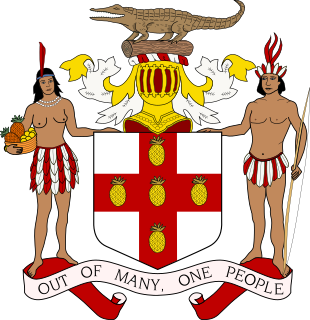
The MMR vaccine is a vaccine against measles, mumps, and rubella. The first dose is generally given to children around 9 to 15 months of age, with a second dose at 15 months to 6 years of age, with at least 4 weeks between the doses. After two doses, 97% of people are protected against measles, 88% against mumps, and at least 97% against rubella. The vaccine is also recommended in those who do not have evidence of immunity, those with well controlled HIV/AIDS, and within 72 hours of exposure to measles among those who are incompletely immunized. It is given by injection.

Rubella, also known as German measles or three-day measles, is an infection caused by the rubella virus. This disease is often mild with half of people not realizing that they are infected. A rash may start around two weeks after exposure and last for three days. It usually starts on the face and spreads to the rest of the body. The rash is sometimes itchy and is not as bright as that of measles. Swollen lymph nodes are common and may last a few weeks. A fever, sore throat, and fatigue may also occur. In adults joint pain is common. Complications may include bleeding problems, testicular swelling, and inflammation of nerves. Infection during early pregnancy may result in a child born with congenital rubella syndrome (CRS) or miscarriage. Symptoms of CRS include problems with the eyes such as cataracts, ears such as deafness, heart, and brain. Problems are rare after the 20th week of pregnancy.

Congenital rubella syndrome (CRS) can occur in a developing fetus of a pregnant woman who has contracted rubella, usually in the first trimester. If infection occurs 0–28 days before conception, the infant has a 43% risk of being affected. If the infection occurs 0–12 weeks after conception, the risk increases to 81%. If the infection occurs 13–26 weeks after conception, the risk is 54% of the infant being affected by the disease. Infants are not generally affected if rubella is contracted during the third trimester, or 26–40 weeks after conception. Problems rarely occur when rubella is contracted by the mother after 20 weeks of gestation and continues to disseminate the virus after birth.
ATC code J07Vaccines is a therapeutic subgroup of the Anatomical Therapeutic Chemical Classification System, a system of alphanumeric codes developed by the WHO for the classification of drugs and other medical products. Subgroup J07 is part of the anatomical group J Antiinfectives for systemic use.

Capsella is a genus of herbaceous plant and biennial plants in the mustard family Brassicaceae. It is a close relative of Arabidopsis, Neslia, and Halimolobos.

Rubella virus (RuV) is the pathogenic agent of the disease rubella, and is the cause of congenital rubella syndrome when infection occurs during the first weeks of pregnancy.
Togaviridae is a family of viruses. Humans, mammals, birds, and mosquitoes serve as natural hosts. There are currently 32 species in this family, divided among 2 genera. Diseases associated with Alphaviruses include arthritis and encephalitis. Rubiviruses such as rubella are sometimes associated with arthritis as well.

The MMRV vaccine combines the attenuated virus MMR vaccine with the addition of chickenpox vaccine or varicella vaccine. The MMRV vaccine is typically given to children between 1 and 2 years of age.
Mumps vaccines are vaccines which prevent mumps. When given to a majority of the population they decrease complications at the population level. Effectiveness when 90% of a population is vaccinated is estimated at 85%. Two doses are required for long term prevention. The initial dose is recommended between the age of 12 and 18 months of age. The second dose is then typically given between two years and six years of age. Usage after exposure in those not already immune may be useful.

North Brewham Meadows is an 8.9 hectare biological Site of Special Scientific Interest at North Brewham in Somerset, England, notified in 1987.

Campomanesia phaea is a species of plant in the family Myrtaceae. The plant is endemic to the Atlantic Forest ecoregion in southeastern Brazil. It is found in the states of Paraná, Rio de Janeiro, São Paulo.

Measles vaccine is a vaccine that prevents measles. Nearly all of those who do not develop immunity after a single dose develop it after a second dose. When rates of vaccination within a population are greater than 92% outbreaks of measles typically no longer occur; however, they may occur again if rates of vaccination decrease. The vaccine's effectiveness lasts many years. It is unclear if it becomes less effective over time. The vaccine may also protect against measles if given within a couple of days after exposure to measles.
Rubella vaccine is a vaccine used to prevent rubella. Effectiveness begins about two weeks after a single dose and around 95% of people become immune. Countries with high rates of immunization no longer see cases of rubella or congenital rubella syndrome. When there is a low level of childhood immunization in a population it is possible for rates of congenital rubella to increase as more women make it to child bearing age without either vaccination or exposure to the disease. Therefore, it is important for more than 80% of people to be vaccinated.

The little woolly mouse opossum is a nocturnal, arboreal and mainly solitary South American marsupial of the family Didelphidae. It is native to the western slopes of the Andes in Colombia, Ecuador and Peru, where it lives at altitudes from sea level to 1500 m. It primarily inhabits lowland rainforest and montane cloud forest, although it has been reported from dry forest in the southern end of its range. It was formerly assigned to the genus Micoureus, which was made a subgenus of Marmosa in 2009. Its conservation status is Vulnerable, due to habitat fragmentation and continuing loss of habitat via urbanization and conversion to agriculture.
Boston exanthem disease is a cutaneous condition that first occurred as an epidemic in Boston in 1951. It is caused by echovirus 16. The disease tends to afflict children more often than adults, although some adults can become infected, and the symptoms have never been fatal. It shows some clinical similarity to Rubella and Human herpesvirus 6

Heteropsis phaea is a butterfly in the family Nymphalidae. It is found in Angola, the Democratic Republic of the Congo, Uganda, Kenya, Tanzania and Zambia. The habitat consists of open Brachystegia woodland.

Visitors to Jamaica must obtain a visa from one of the Jamaican diplomatic missions, or in certain cases from one of the United Kingdom diplomatic missions, unless they come from one of the 116 countries designated as visa-exempt countries or countries whose citizens may obtain a visa on arrival. Most Commonwealth Citizens can visit Jamaica for up to 180 days visa-free.

Tetraopini is a tribe of longhorn beetles in the subfamily Lamiinae.
Phaea is a genus of longhorn beetles of the subfamily Lamiinae, containing the following species:















